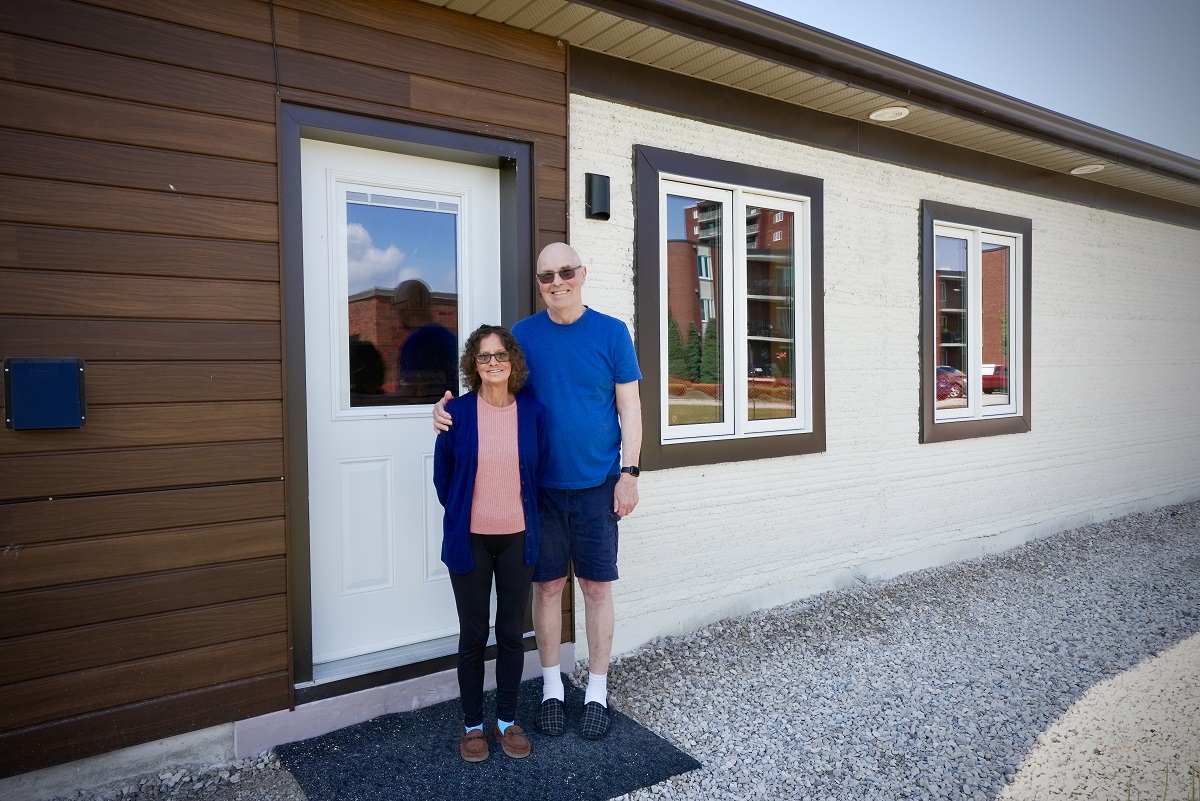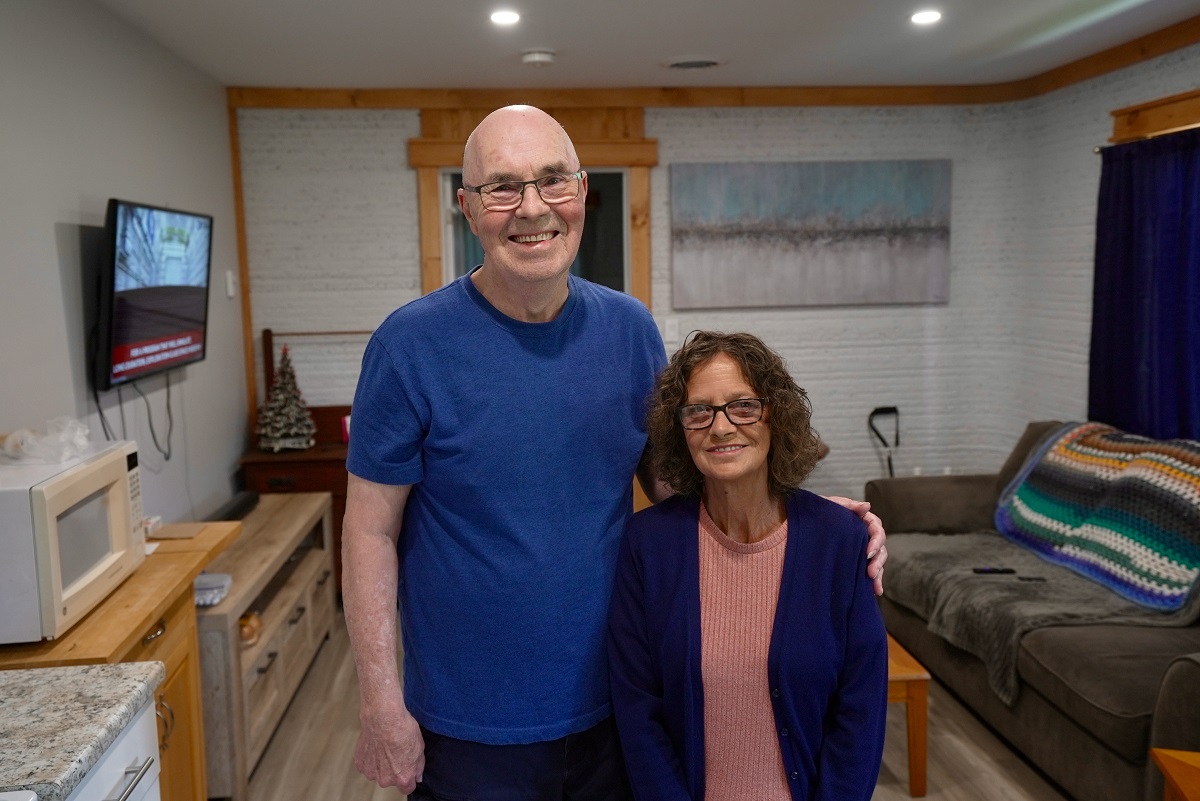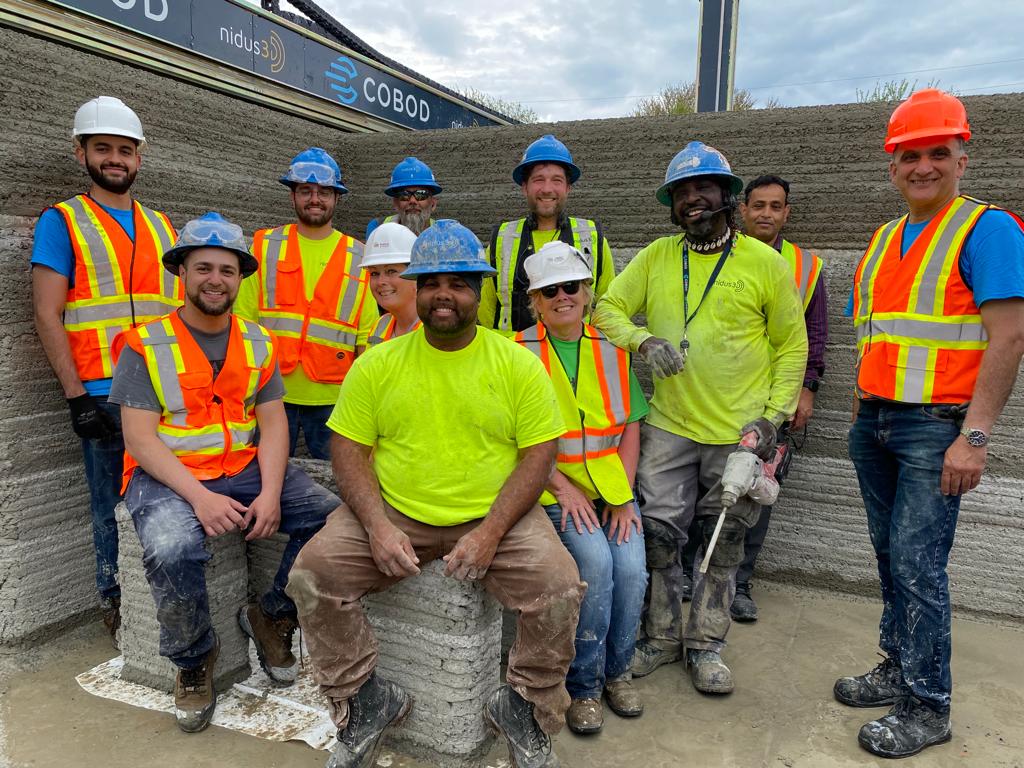Canada’s first 3D printed multi-unit homes - Part 3 of 3
May 3rd, 2024
AT A GLANCE
- Residents move into 3D printed homes and enjoy affordable, reduced-maintenance living.
- The Bridge Youth Resource Centre becomes Canada’s first 3D constructed residential housing provider.
- Leamington project sets the bar for 3D residential home construction printing in Canada.
- Partners hope to inspire others across Canada to explore the potential of 3D construction printing as an efficient, sustainable housing solution.
(Visual: a bird’s-eye view over a field. The camera cuts to a big warehouse tent with a man walking inside. The camera cuts to a glass university building. The camera cuts to the CHMC sign. The camera cuts to the Habitat for Humanity for Windsor-Essex sign. The camera cuts to a construction site.)
NARRATOR: From a windy warehouse on the shores of Lake Ontario to an innovative university exploring how tech could help build more homes faster and more affordably, one game-changing meeting between Canada's housing agency and one of the country's leading housing providers kickstarted a first-of-its-kind project: 3D-printed homes.
(Text on screen: 3D PRINTED HOMES. Canada’s first 3D printed multi-unit residential homes)
(Visual: A road sign reads, “Municipality of Leamington population 31,000. The camera cuts to a truck driving down a road. The camera cuts to the Leamington Municipal Building.)
FIONA: In Windsor and Essex County, there are 6,500 families on a waiting list for our community subsidized housing.
(Text on screen: Fiona Coughlin, CEO, Habitat for Humanity, Windsor-Essex)
FIONA: We know that there’s an additional about 4,000 families that are about one paycheck away from losing their housing stability.
(Visual: A large university building with a green roof. The camera cuts to six people wearing masks standing in a construction site. The camera cuts to the 3D printer. The camera cuts to the Habitat for Humanity building.)
FIONA: So how that project came about. The University of Windsor was working on research. There were printers that really wanted to build houses, and CMHC was a funder, funding innovation and Habitat for Humanity is known for providing safe, decent, affordable housing. So together, I believe all three of those groups were going to achieve the outcomes that CMHC wanted.
(Visual: The camera pans across a sign that reads “Canada Mortgage and Housing Corporation” next to a building. The camera cuts to a scene inside the building. A man walks inside. On the wall is indicated, “Innovation Centre.” The man walks into a conference room.)
(Text on screen: Jonathan Laflamme, CMHC, Climate Change Initiatives Advisor. Jonathan Laflamme, the man speaking appears on camera.)
JONATHAN: We had been exploring innovations in the construction industry that could bring more affordable units to the market, cheaper and faster. We identified 3D construction printing as an opportunity. We raised it during a call with Habitat and they loved the idea.
The University of Windsor had also been following the progress of 3D printing around the world for about three years.
(Visual: A construction site where a structure is being printed using a 3D printer.)
JONATHAN: So together we agreed to examine it more closely.
(Text on screen: Dr. Sreekanta Das, Professor of Civil Engineering, University of Windsor. Dr. Sreekanta Das, the man speaking appears on camera.)
DR. DAS: This project, funded by CMHC, gave the students the opportunity to apply the technical and managerial skills in real-world construction. I'm thankful to CMHC.
(Visual: Construction workers working on machinery. The camera cuts to building plans on a wall. The camera cuts to a person measuring distances using a ruler on a building plan.)
NARRATOR: Habitat for Humanity and the University of Windsor submitted proposals to CMHC for the research and development of a four-unit, 3D-printed development.
(Visual: An internet search being performed in the Google search engine using the words “3D Printed Homes.” The camera cuts to a 3D printer. The camera cuts to the Nidus3D building)
NARRATOR: When the proposals were approved, Habitat assumed the role of project lead and the university began searching for a company with a printer large enough to 3D-print four houses.
(Visual: A close-up of the door where the words “Nidus3D” can be seen.)
IAN: Nidus3D is Canada's leading construction printing company.
(Visual: The Nidus3D outdoor warehouse where a big white tent with the company logo stands.)
(Text on screen: Ian Arthur, Founder, Nidus3D. Construction Printing. Ian Arthur, the man speaking appears on camera.)
IAN: We do 3D construction printing, where we use the big machine that you can see right behind me to stack layers of concrete to build housing.
(Visual: Inside the warehouse tent, the Nidus3D logo is on the 3D printers. The camera cuts to more equipment from the constructions site.)
IAN: We're using a standard construction material, this structural concrete that we use, and we're just deploying it in a new way. We got a call out of the blue from Habitat Windsor-Essex from Fiona. She messaged me on LinkedIn and said, hey, could you guys come in and print something?
(Visual: Ian Arthur, the man speaking appears on camera.)
IAN: And it was about three months earlier than we'd intended to really print anything outside of a warehouse sort of testing setting. So, we kind of accelerated a lot of stuff very, very quickly and got the equipment down to Windsor.
(Visual: A shoreline with a few tall buildings. The camera cuts to a photo of a man shovelling cement. The camera cuts to 6 people standing and looking at the camera for a photo, 3 of them are wearing reflective vests. The camera cuts to a worker attaching a piece of equipment on bigger machinery. The camera cuts to a close-up of someone’s hands holding a tablet. The camera cuts to a close-up of the workers preparing heavy machinery.)
NARRATOR: Under the guidance of Dr. Sreekanta Das, professor of Civil Engineering at the University of Windsor, a team of three students was formed. Together they led on-site research and testing, assisted with on-site project management, and coordinated the design and printing of the 3D files. But one question remained.
(Visual: Fiona Coughlin, the woman speaking appears on camera.)
FIONA: Where are we going to put these houses?
(Visual: Aerial view of a beach. The camera cuts to a view of a parking lot and houses. The camera cuts to a view of a rocky shoreline.)
NARRATOR: Nestled on the northern shores of Lake Erie, the town of Leamington has a population of almost 30,000.
(Visual: A view of the road where the town’s road sign is visible, a truck drives by. The camera cuts to another sign by the road where the words “Tomatoes, Peppers, Cukes” are written. The camera cuts to a vegetable stand adorned by a big red tomato sign that reads, “Tomatoes.” The camera cuts to someone’s hands, picking up tomatoes next to some basil. The camera cuts to an aerial view of agriculture land.)
NARRATOR: This number fluctuates throughout the year and peaks during the summer months as temporary workers arrive to support the town's massive agricultural sector.
(Visual: Fiona Coughlin, the woman speaking appears on camera.)
FIONA: I knew that they had enough infrastructure in this town to support the effort that needed to come together to make this development happen.
(Visual: A view of a boat on the lake, the camera cuts to an aerial view of agriculture land. The camera cuts to a sign that reads, “THE BRIDGE. LEAMINGTON YOUTH RESOURCE CENTRE.”)
NARRATOR: Having previously worked with Habitat on several housing developments, Mayor Hilda MacDonald was keen to create more affordable housing. She connected Fiona with The Bridge Youth Resource Centre.
(Visual: Krista Rempel, Executive Director, The Bridge Youth Resource Centre, the woman speaking appears on camera. The camera cuts to multiple angles of the 3D printers and the workers working on them.)
KRISTA: They knew of our organization and that we were looking to build homes and that we had the land to do so, and so the connection happened from there.
(Visual: Ian Arthur, the man speaking appears on camera.)
IAN: In many ways, the Leamington project was an ideal site for printing and especially one of our first projects. It was large, there was a lot of laydown area. The equipment is very, very big, and even just moving it off the trucks and having enough room to place it somewhere prior to assembly is really important.
(Visual: Showing different angles of the construction workers working on the 3D construction site.)
NARRATOR: In close collaboration with Nidus3D, the university researchers printed samples in identical conditions to the building and took them back to the lab for testing.
DR. DAS: The University of Windsor has one of the largest structural testing labs in Canada, and this has allowed us testing full-scale load tests on the wall and other structural components printed in the side.
(Visual: Pressure testing being performed on the 3D printed walls. The camera cuts to various angles of the construction site and the machinery. The camera cuts to a view of the walls almost fully printed.)
FIONA: They came back and said, you can park 90 cars on that house because that's how much pressure the wall can take.
NARRATOR: As the building took shape, The Bridge prepared to take on a new role as landlords of Canada's first multi-unit, 3D-printed homes.
(Visual: Krista Remple, the woman speaking appears on camera.)
KRISTA: We put together an application form and we had a committee go ahead and select those that were going to be successful in their tenancies here.
(Visual: A close-up of the sign that reads, “THE BRIDGE. LEAMINGTON YOUTH RESOURCE CENTRE.” The camera zooms out from an aerial view of the house being completed. The camera cuts to an aerial view of agriculture land.)
NARRATOR: Lou and Tommy Malott had been following the development on local news.
(Visual: Lou Malott appears on camera sitting on a sofa, next to his wife drinking from a cup.)
NARRATOR: A cancer diagnosis left Lou unable to work, and the stress of maintaining a home forced them to sell and look for a more manageable alternative.
(Visual: Lou Mallott, resident, 3D-printed home and Tammy Malott, resident, 3D-printed home. The woman speaking appears on camera sitting next to her husband.)
TAMMY: Compared to the cost of owning a home.
LOU: Yeah.
TAMMY: And now renting here, it is a lot easier.
(Visual: Lou Malott walking in front of his 3D-printed home. The camera cuts to a close-up of the front of the house. The camera cuts to inside their home as they watch TV together on the sofa. The camera cuts to the inside of the bathroom, panning across the room. The camera cuts to Lou Malott speaking on camera next to his wife on the sofa.)
LOU: For me, just to have a shower or a bath before was a problem, a big problem, so I had to step over the tub and everything. I fell, and I banged my head and stuff like this. So now it's all level sort of. But the shower is better. It gives me a chance to just concentrate on the fight, you know, because you do fight.
(Visual: Different angles of Lou and Tammy Malott in their house.)
NARRATOR: This incredible project has transformed the housing outcomes for its residents. It has also helped to reshape the conversation around residential construction.
(Visual: Ian Arthur, the man speaking appears on camera. The camera cuts to the Nidus3D construction site. The camera cuts to an aerial view of the beginning of a 3D-printed construction project. The camera cuts to multiple construction scenes.)
IAN: The challenges that the construction sector are facing are enormous. So, any technology that begins to address those sort of challenges through some partial automation, like what the 3D printer does through consolidating fabrication in centralized locations like modular does, all of these, I think, are going to play a role.
(Visual: Dr. Sreekanta Das, the man speaking appears on camera. The camera cuts to multiple close-ups of the 3D printers in action.)
DR. DAS: The data we gathered through the testing, full-scale testing of the structural specimen printed, and also the knowledge we learned from the housing project in Leamington will help us developing various future design standard in the code, like STM and ISO that will help us, designing and building the future 3D-printed house.
(Visual: Multiple close-ups of the 3D printers in action, the camera cuts from one scene to another showing the evolution of a 3D-printed house.)
FIONA: I think the nice thing about Habitat for Humanity is that we work to address the needs in our unique communities. This becomes part of Habitat's toolkit that could be used across the country.
(Visual: Multiple workers sit in front of a finished wall and smile for the camera. The camera cuts to another photo of 7 people smiling for the camera. The camera cuts to another 5 people, 3 of them wearing reflective vests smiling for the camera. The camera cuts to a photo of a ribbon-cutting ceremony involving 10 people. The camera cuts to a close-up of the following people one after the other: Krista Rempel, Fiona Coughlin, Dr. Sreekanta Das, Ian Arthur, Jonathan Laflamme, Lou and Tammy Malott. The camera shows the CMHH logo on a white background.)
JONATHAN: What the partners achieved on this project is incredible. They've set the stage for further development of 3D construction printing as a housing solution. True housing innovation.
With the finishing touches complete on Canada’s first multi-unit 3D printed homes development, The Bridge Youth Resource Centre began the final step – choosing residents.
“They weren’t easy decisions,” says executive director Krista Rempel. “Something we’ve learned through this initial stage of our development is that we have more applicants than we have homes.”
Downsizing to affordable living
Married for almost 20 years, Leamington residents Lou and Tammy Malott had not expected to move from their most recent home.
“I thought we would be there forever and grow old together,” says Lou. “Never anticipated any of the rest of it.”
In 2021 Lou was diagnosed with stage 4 lung and liver cancer. The stress of managing Lou’s illness while maintaining a house weighed heavily on the couple.
Compared to the cost of owning a home, and now renting here, it’s a lot easier.”
“I’d been working and then all of a sudden, nothing. Paying the bills was getting very tight. We were both stressed out.”
They had already sold their home and were living with Tammy’s cousin when Tammy saw The Bridge’s housing application on Facebook. They submitted right away and were very happy to hear they had been successful.

“Compared to the cost of owning a home, and now renting here, it’s a lot easier,” says Tammy.
Downsizing from a family home to a 560-square foot one-bedroomed unit was a challenge but the layout is a better fit for their needs.
“For me, just to have a shower or a bath before was a problem because I had to step over the tub,” says Lou. “I fell, one time and I banged my head and now it’s all [one] level.”
Their children and grandchildren have stopped by, “though now it’s one at a time,” laughs Tammy.
Mostly, they appreciate the peace and quiet that their new home provides.
“It just gives me a chance to concentrate on the fight. Y’know?” says Lou.

More homes on the horizon
Once all 4 units were occupied, The Bridge rolled right into the next phase of their housing plan.
“We received funding through the Rapid Housing Initiative to develop 8 modular homes,” says Krista. “And so very shortly we will have 12 homes on site.”
An additional 30-38 homes will serve local youth and the wider community.
“The opportunity is that we will have market, mid-rate and affordable homes throughout our development and those rental dollars will help sustain us long term.”
Transformative impact
The pioneering 3D homes project has not only transformed the local landscape, it has also transformed the conversation around residential construction.
“When we talk about housing across the country there’s no one right solution,” says Fiona Coughlin, chief executive officer, Habitat for Humanity Windsor-Essex. “You have to look at all the opportunities out there.”
Our hope is that the housing community and builders in Leamington will see our finished homes and our research and consider 3D printing as an option to address their needs.
For Leamington, “our hope is that the housing community and builders in Leamington will see our finished homes and our research and consider 3D printing as an option to address their needs.”
She would also like 3D homes to become part of Habitat’s toolkit, to be implemented across the country according to community need.
“Our work signifies a transformative shift in the way homes are built, not just within Canada but potentially worldwide,” says Dr. Sreekanta Das, Professor, Civil and Environmental Engineering, University of Windsor.
“I am proud to be part of a project that has the potential to revolutionize the construction industry and significantly contribute to a more sustainable future.”

Environmentally sensitive, rapid and affordable
More than one year since the homes were completed, Nidus3D founder Ian Arthur is very pleased with their performance.
“Our buildings are performing to about R40 so very warm in the winter and cool in the summer.”
At the University of Windsor, Dr. Das and his affordable and sustainable housing research team continue to look for ways to enhance the durability and weather resistance of 3D printed structures.
“We are exploring the development of eco-friendly printing materials using recycled materials such as reclaimed concrete from demolished buildings and recycled glass bottles,” he says.
The overall goal is to minimize environmental footprint and reduce CO2 emissions.
It holds the potential to become a mainstream method for swiftly constructing affordable and environmentally sustainable homes.
Based on the research Dr. Das anticipates, “future 3D-printed homes will become even more environmentally friendly, playing a significant role in addressing landfill problems and promoting sustainability.”
Ian agrees.
“The potential for 3D construction is enormous. I mean we wouldn’t have started the company if we didn’t see some path to it being broadly implemented in Canada.”
As efficiencies of scale increase, so does the potential for affordability.
“One of the really promising things is the speed at which you can deliver the building. Right now, we are able to print between a third and half a storey per day and we see that increasing tremendously.”
I think we still start to see printers as well as cranes on city skylines in the not-too-distant future.
3D printer manufacturer Cobod, is also exploring larger printers which would facilitate low- and mid-rise buildings as well as large commercial structures.
“I think we still start to see printers as well as cranes on city skylines in the not-too-distant future,” says Ian.
The portability of the printers also presents a promising solution for remote communities.
“Our printers can shrink down into a couple of C Cans and be transported with stable raw materials that enable you to rapidly work on building housing in the shortened building season.”
A proud legacy
Krista and Fiona have travelled a long road together over the last 2 years, and their journey continues, as they share their experiences and lessons learned at speaking opportunities across the country.
“One of the key things that Fiona and I have talked about is that this project wouldn’t have been possible without each other and the collaboration of our partners,” says Krista.
Fiona agrees. “What I learned from this experience was that collaboration is how you move mountains.”
Sadly, project pioneer Terry Petkau passed away in December, 2022. But, Fiona says, he saw the completed houses.
“It was one of his proudest achievements. We’re really proud of him.”
KEY FACTS
- The Leamington 3D printed homes project was developed and produced by Habitat for Humanity Windsor-Essex, in collaboration with The Bridge Youth Resource Centre, the Faculty of Engineering, University of Windsor, Nidus3D and the Town of Leamington.
- The research and development of the Leamington 3D homes project was funded by CMHC, in support of the National Housing Strategy.
- 3D construction printers for the Leamington project were provided by Demark-based COBOD.
SEE ALSO






 Share via Email
Share via Email
